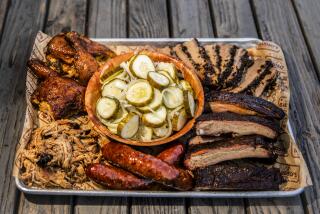The Hardwood Stuff: How You Can Take Up Smoking
Having a dedicated smoker certainly makes the job easier, but you can smoke in any barbecue that has a lid. Your manufacturer probably included instructions.
The basic principle is to put pieces of hardwood over the heat source, close the lid and keep the temperature low (by fiddling with the top and bottom vents, in a charcoal grill) so thereâll be plenty of smoke and the meat will come out moist and tender. The ideal temperature is around 225 degrees. Many grills include a thermometer (usually indicating the âdesirable rangeâ but not degrees). Others can be fitted with a thermometer sold at a barbecue supply store. Some people just stick a candy thermometer in the smoke vent.
An oven thermometer is not practical--you have to open the barbecue to read it, losing heat and smoke every time, and in any case the dial soon blackens and becomes unreadable--but itâs worth using once to get an idea what your grill maker means by âdesirable range.â Itâs probably desirable for grilling but too hot for smoking.
If youâre using a charcoal barbecue, youâll have to fire up more fuel and add it to the fire box every hour or so to keep the temperature even. This gets tiresome when youâre cooking brisket, which can take up to 12 hours. You donât need to monitor the fuel or temperature with an electric smoker (you just dial the temperature setting and forget about it), but most electric models (like many charcoal smokers) have a water pan that shouldnât be allowed to run dry or the meat will dry out.
Gas barbecues designed for smoking will probably be common someday. For now, though, gas barbecues tend to burn too hot. Smoking on gas is easiest if your grill has two burners with independent controls. Light one, turn it down as far as possible and stick the container of wood over it; put the food over the unlit burner. Keep a close watch on the temperature.
The Time
Cooking times depend on what youâre cooking and how thick it is. At 225 degrees, baby-back ribs should be done in about two hours, chickens in three, a 5-pound pork butt in six hours, a 12-pound turkey in 10 and a beef brisket in 12 hours.
If your smoker is heated with charcoal, you donât have positive control over its temperature and you should check the meat for doneness every once in a while. Ribs are done when the meat is tender and starts pulling away from the bone. Chicken or turkey is done when the leg bone moves easily in its socket. For thick cuts such as shoulder or brisket, you may want to cut off a piece to assess its doneness.
Most fish will smoke in an hour or less. Itâs a good idea to smoke thin filets at a lower temperature; say, 200 degrees. Fruits and vegetables, such as pineapple or eggplant, should be done in an hour at 225 degrees.
The Seasonings
Some barbecuers feel no need for adding seasonings, but well-smoked meat with a good spice rub is flavorful enough to eat without any sauce.
Most rubs are basically salt, red pepper and black pepper. You can vary this with all sorts of other flavorings: mustard, celery seed, garlic salt, curry powder, dried herbs such as rosemary--the list is endless. Rub the spices generously into the meat the night before barbecuing or at least a couple of hours ahead. In the case of chicken, oiling the skin before rubbing it will make it cook a little crisper.
The Wood
The kind of wood to use is a matter of taste, though itâs widely agreed that alder is the best for smoking fish.
Hickory or pecan gives a classic Southern flavor, and the brusque, tarry aroma of mesquite (which is easy to overdo) goes with Southwestern food. Fruit hardwoods, such as apple or cherry, give a sweet aroma. (Peach, apricot and plum wood are fine, but they lose their flavor if the wood is stored too long.) Avocado wood has a mellow aroma of its own. Many grill masters like to make âcocktailsâ of a neutral wood, such as oak, with more flavorful hardwoods.
If youâre using backyard trimmings, make sure the wood has dried out thoroughly or it will blacken the meat. Thin branches need only a month or two, logs will take a year. Never use a softwood such as pine, fir or eucalyptus; they impart a penetrating pine-sap taste.
Barbecue supply shops stock hardwood for smoking, but the usual thin chips are really for adding smoke flavor to ordinary grilled food. Since smoking is a much slower and longer process, buy wood chunks an inch thick or be ready to add chips from time to time.
More to Read
Eat your way across L.A.
Get our weekly Tasting Notes newsletter for reviews, news and more.
You may occasionally receive promotional content from the Los Angeles Times.










